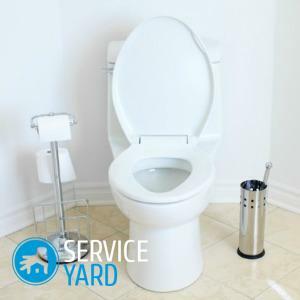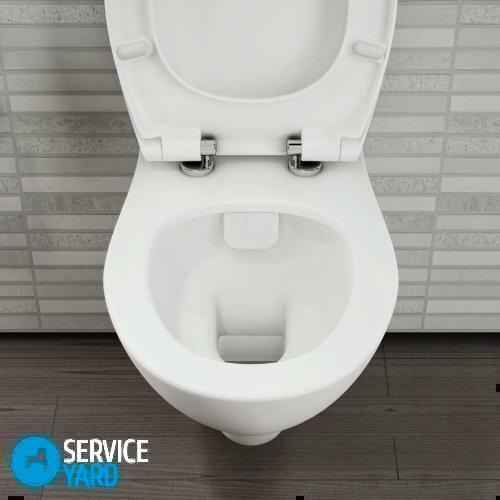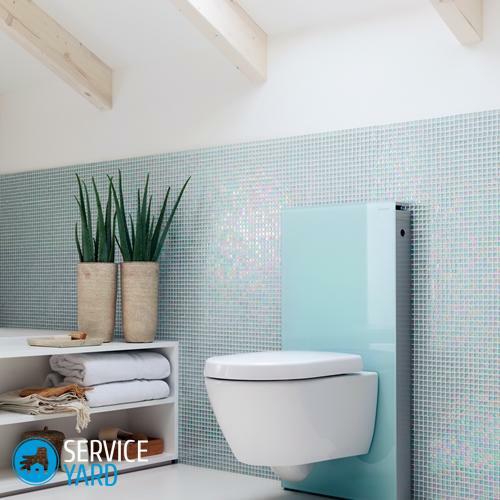
- Why is the raid formed?
- How to avoid serious pollution?
- How to clean the toilet bowl to white at home?
- How to bleach the toilet bowl at home with folk remedies?
- Useful advices:
It's nice when the plumbing in the house shines clean, and according to the rules of hygiene, just a good tone, there should be a sterile environment in the bathroom. But sometimes the toilet is covered with a brown coating, and then the question arises: how to clean the toilet from the urinary stone at home and return it to impeccable whiteness? In the article we will tell you why there is plaque and rust in the tank and on the toilet, and what tools to use to combat pollution.
to the contents ↑Why is the raid formed?
To understand how to solve the problem, which drugs to use, you must first find out the type of pollution, the cause of its appearance.
The main enemies of the white toilet bowl:
- Uric stone.
- Rust.
- Calcareous plaque.
Let's get acquainted with the enemies closer.

Urinary stone
The most important enemy, from which it is very difficult to get rid of - is a urinary stone. Usually, it accumulates in the lower part of the toilet - where water always stands. The urinary stone consists of complex mineral salts that enter the toilet together with urine. The problem with brown deposits occurs in families where households often forget to wash themselves or, if the toilet itself is rarely subjected to preventive treatment.
Settling on the walls of sanitary ware, the salt deposits turn into a rather thick layer of brown color. Because of this deposition, the diameter of the drain may even decrease. Therefore, ideally, with a urinary stone, it is necessary to fight as it forms, and not wait until it becomes "impenetrable," because then, conventional chemical agents can not cope with it.
Rust
The appearance of rusty stains is associated with water quality, the state of the metal parts of the pipe, the drain tank. The quality of the water falling into the sink can be influenced by old rusty plumbing pipes. In addition, if the rubber gaskets do not completely cover the drain, and the used metal parts are of poor quality, the rust formed on them will gravitate from the tank to the toilet bowl and form an unaesthetic rusty strip.
Lime scale
Such a contaminant is less common, as it occurs in houses with increased water hardness containing calcium salts. The higher the hardness of water, the faster the plaque will form. Calcium salts, in due course, settle in a tank and on a toilet bowl, and on top, on a limy deposit, other pollution quickly are formed. Helps rid of the lime plaque that contain acidic acids.
to the contents ↑How to avoid serious pollution?
With different kinds of contaminants it is easier to cope at the stage of appearance. In order not to look for, than to clean the toilet from rust and plaque with your own hands, adhere to simple preventive measures:
- Eliminate leaks from the toilet bowl. Sometimes it is enough to adjust the float and the toilet will not overflow, and on its walls there will be no traces of rust.
- Get the tablets for the drain tank. Drugs, though slowly, but still hinder the deposition of salts. In addition, the tablets give the water a pleasant smell, color, help dissolve the already formed plaque.
- Use different filters to improve water quality.
- Make sure that mechanical damage is not generated on the surface of the toilet bowl. A porous, rough surface accelerates the formation of deposits. Do not use a toilet brush, a metal brush, or a tool with coarse abrasive substances. In addition, hot water should not be poured into the toilet bowl, as microcracks are formed on the surface of sanitary ware at this exposure.
- Do not forget to clean the plumbing, at least once a week. Apply a cleaning agent, after half an hour, wipe with a brush and rinse.
How to clean the toilet bowl to white at home?
Before solving the problem of how to clean the toilet bowl from the urinary stone at home, decide whether it is worth the effort that you intend to spend cleaning the plumbing. If it is quite old, it's easier to buy a new one, especially if the thicket has already served its end in the last millennium.
If the ceramic "participant in the process" is dear to you as a memory or there is no possibility to purchase a new one, then get down to business and get a toilet cleanser in your shop with your own hands. As in all cases, the methods of solving any problem are divided into sparing and radical ones. We introduce you to the means of household chemicals that will help remove urinary stone in the toilet.
What can household chemistry offer?
Industry offers a huge number of solutions and powders. To divide all preparations it is possible on four basic groups, each of which in own way operates and in any degree allows to clear a toilet bowl from a urinary stone in house conditions.
Abrasive cleaning powders
An example of such a tool may be "Pemolux".The cleaning principle is quite simple. Your actions:
- Wear rubber gloves.
- Bleed all the water from the tank and toilet bowl.
- Add the product to the surface of the plumbing.
- Using a soft sponge or rag, wipe off the dirt until a snowy surface appears.
Important! With frequent use of powder on the surface of the plumbing may appear micro-scratching, and the surface will become rough. Therefore, give preference to gels and cream formulations. In addition, they are more economical and easy to use.
Alkaline agents
Liquid preparations contain caustic soda. They dissolve the urinary stone and remove the surface of the sanitary ware from contamination. Drugs are well disinfected, do not damage the plumbing. Alkaline preparations perfectly dissolve fats, which allows to remove clogs of organic origin.
To clean the toilet with alkali, proceed as follows:
- Bleed the water from the toilet bowl and the tank.
- Apply to the surface of the plumbing.
- Leave the bathroom for half an hour.
- Rinse all residues with water.
- Repeat the procedure if necessary.

Important! Please note that such products have a rather caustic and specific smell, and also do not work best on the skin. Therefore, always use protective equipment - gloves, mask, glasses. Otherwise, you can clean the toilet bowl from the urinary stone at home, but in exchange you will get health problems.
Chlorine-based products
Suitable for daily care, perfectly cleaned, disinfected, does not corrode the coating, does not form microcracks. On sale are present as a concentrated solution and powder.
Drugs excellently remove odors, but after themselves leave a smell of chlorine.
Important! The most popular remedy with such compositions is the familiar "Whiteness", it will cost inexpensively, which is an undoubted plus.
Acid Cleaners
These chemicals will defeat the most chronic deposits of urinary stone and rust. Apply them in the same way as alkaline agents. However, it is often not recommended to use acidic preparations, since they contain aggressive substances: oxalic, hydrochloric, formic, orthophosphoric acids and their mixtures, which are able to some extent corrode the coating. And a couple of acids have a very bad effect on human health.
As an example, the leaders of the group of acid products - "Sillit", "Domestos".Drugs are produced in convenient plastic bottles. The curved nozzle of the container allows you to apply the product directly under the rim of the toilet bowl.
to the contents ↑How to bleach the toilet bowl at home using folk remedies?
Our mothers and grandmothers had to deal with hygiene in the bathroom long before the appearance of special household chemicals. Our ancestors knew how to clean the toilet bowl from the urinary stone at home with improvised means.
We suggest you also to use their recipes:
- A glass of 9% vinegar is heated to 40 degrees and poured into an empty bowl of the toilet for several hours. This method is able to remove a significant part of the stone and lime scale. To enhance the effect, add a little iodine, salt or soda( 1 tablespoon of soda to a glass of vinegar).All cleaning procedures are carried out in the evening to leave the solution for the whole night. The urine stone will become soft, supple, accordingly - it can be easily removed.
- Will solve the problem and acetic essence with a concentration of 70%.Pour out all the water from the toilet bowl, fill the emptiness with essence. Leave the plumber for 1.5-2 hours. To enhance the effect, add iodine solution to vinegar, in a 1: 1 ratio. After the cleaning procedure, wipe the surface with a brush.
- Citric acid is a worthy alternative to vinegar. Pour two or three tablespoons of acid into an empty toilet bowl and a container. Leave the remedy for several hours. Brush and rinse. Repeat the procedure several times until you completely clear the toilet from the urinary stone.
- Soda is able not only to enhance the action of acetic acid, but it also perfectly copes with impurities. At night, pour a whole batch of soda into the toilet and leave it till morning. When you wake up, lightly brush the surface of the sanitary ware with a brush and rinse the remaining dirt.
- "Coca-Cola".This folk recipe was born recently. Pour 1-1.5 liters of liquid into the dry bowl of the toilet bowl and leave overnight. The soda will quickly erode deposits.
We use "heavy artillery"
If all the attempts made did not give the expected effect, then use strict measures to clean the toilet from the urinary stone:
- Dry oxalic acid. This agent is used in the chemical industry. Apply the acid to etch the surface before applying enamel. Sold in the form of powder. Apply the product to a piece of cloth and wipe the plaque. You can use another method: dissolve a large amount of the product right in the toilet. After use, rinse the acid and clean the surface with a brush. Remember that when using acid, you must adhere to safety measures.
- Hydrochloric acid. The product is sold in sanitary ware shops. Use acid to clean water heaters in columns and gas boilers. Liquid pour into the toilet, and after 0.5-1 hour wash. Disadvantage: can not be used if the sewer pipes are made of plastic.
- iodine monochloride. Liquid can be purchased at veterinary pharmacies. With a solution, pour all contaminated areas and immediately rinse with water. The liquid product perfectly removes all kinds of stone, and the calcareous deposits and rust eats away within a few minutes. Disadvantage: can not be used in houses with cast-iron sewage pipes. In addition, iodine monochloride is aggressive to aluminum.
- Electrolyte for acid batteries. The remedy will remove all hard-to-remove undesirable deposits quickly and efficiently. Apply the electrolyte for half an hour and wash it off with water. Disadvantage: use very carefully with the use of protective equipment, can not be used in houses and apartments with plastic pipes.
Important! When working with chemicals, use rubber gloves, a protective gown and a respirator. Do not close the door to the toilet, during treatment. After cleaning, thoroughly flush the plumbing and ventilate the room well.
to Contents ↑Advice:
- Do not use strong agents too often, as they spoil the coating and leave on the surface of microdamage. Once, hard by removing urinary calculus and calcareous deposits, regularly carry out preventive measures using more gentle cleansers.
- Always clean the toilet bowl before cleaning. Buck up the water with a plastic container, and remove the moisture residues with a rag.
- In addition to preventive cleaning and sediment control, be sure to adjust the water supply to the tank. Excess water for flushing is not only economically unprofitable, but also one of the reasons for the appearance of calcareous plaque. The easiest way to reduce the amount of water supplied is to place 1-2 plastic containers of water in the tank. Savings: 2-3 liters with each use. If you purchase new sanitary ware, choose a tank with a double button and a function of economical use of water.
When answering the question of how to clean the toilet, the choice of tools and methods is always left for the user, since it is necessary to take into account not only the features of the sanitary unit, but also the type of material, the degree of contamination and the presence of microcracks and damages. If deposits have appeared recently, then resort to radical methods is not necessary - start with folk, proven means, because you can also clean the toilet with vinegar, if its smell does not irritate you. We hope that the information obtained will help you keep your plumbing in perfect cleanliness.
